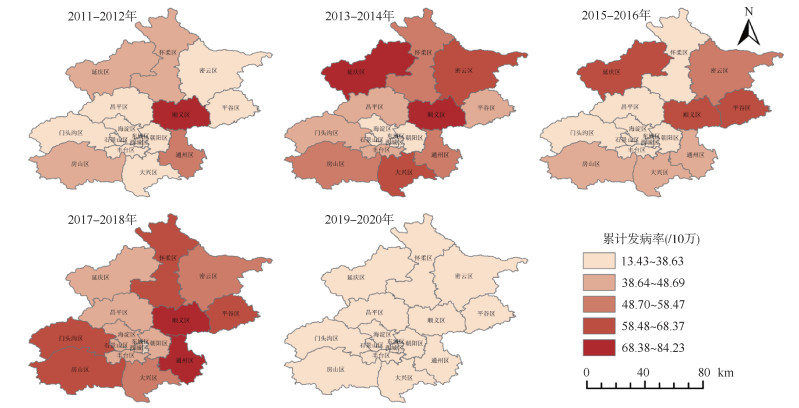文章信息
- 董帅兵, 王小莉, 霍达, 李仁清, 杨扬, 梁志超, 王全意, 贾蕾.
- Dong Shuaibing, Wang Xiaoli, Huo Da, Li Renqing, Yang Yang, Liang Zhichao, Wang Quanyi, Jia Lei
- 北京市2011-2020年6岁及以上人群手足口病流行特征分析
- Epidemiological characteristics of hand, foot and mouth disease among people aged 6 and over in Beijing, 2011-2020
- 中华流行病学杂志, 2022, 43(2): 207-212
- Chinese Journal of Epidemiology, 2022, 43(2): 207-212
- http://dx.doi.org/10.3760/cma.j.cn112338-20210511-00387
-
文章历史
收稿日期: 2021-05-11
手足口病是由肠道病毒引起的儿童常见的急性传染病,主要以肠道病毒A组71型(enterovirus group A 71,EV-A71)、柯萨奇病毒A组16型(cosackievirus A 16,CV-A16)和柯萨奇病毒A组6型(cosackievirus A 6,CV-A6)病毒为主[1]。多数手足口病患者为自限性疾病,其特征为手、足和口腔黏膜疱疹或溃疡,少数病例可能出现脑膜炎、肺水肿、循环障碍等,甚至死亡[2]。20世纪90年代以来,手足口病在亚太地区大规模流行[3]。2008-2020年我国累计报告手足口病超过2 300万例,重症超过15万例,发病数和发病率居法定报告传染病之首,造成了巨大的疾病负担[4]。手足口病以≤5岁儿童易感,当前研究也大多为≤5岁儿童。有研究表明,成年人也可罹患手足口病甚至进展为重症病例[5],但鲜有报道≥6岁人群手足口病流行病学特征。本研究分析2011-2020年北京市≥6岁人群手足口病流行病学特征,为科学防控大年龄组人群手足口病提供依据。
资料与方法1. 资料来源:北京市≥6岁手足口病病例数据和人口数据分别来源于中国疾病预防控制信息系统传染病报告信息管理系统。按录入日期收集2011年1月1日至2020年12月31日北京市≥6岁手足口病个案。病例信息包括基本人口学信息、发病日期、诊断日期、死亡日期(死亡病例)、是否为重症等。
2. 病例定义[6-7]:手足口病临床诊断病例指患者手、足或臀部出现斑丘疹或者疱疹,口腔出现疱疹或者溃疡,伴或不伴发热。如果临床诊断病例通过RT-PCR、病毒分离或者中和试验的方法确定为肠道病毒(EV-A71、CV-A16、CV-A6或者其他肠道病毒阳性)感染,则为实验室确诊病例。
3. 病原学监测:北京市建立了基于16个区的29家哨点医院的手足口病病原学监测。各区(县)哨点医院由经过培训的门诊医务工作者每月至少采集前5例轻症手足口病病例的标本,如不足5例,则全部采集。采集的标本有咽拭子、粪便、疱疹液、血液、脑脊液等。所有重症及死亡病例要求必须采样。各区CDC负责在48 h内对所有标本进行病原学检测,其中采样和检测方法严格按照《手足口病预防控制指南(2009年版)》操作[8]。主要检测方法为real-time RT-PCR,阳性的标本进一步进行EV-A71及CV-A16分型检测,自2013年起,北京市开始对肠道病毒阳性的标本进一步开展CV-A6核酸检测。
4. 统计学分析:用Excel 2013软件对数据进行整理,并使用SPSS 19.0软件进行统计学分析。采用描述性统计方法分析北京市2011-2020年≥6岁人群手足口病发病率、性别比和年龄构成等指标。采用趋势χ²检验分析手足口病构成比随时间的变化趋势。构成比(%)=≥6岁手足口病病例数/同期全人群手足口病报告病例数×100;发病率(/10万)=≥6岁手足口病发病数/同期≥6岁常住人口数×100 000。病例的地区分布特征采用ArcGIS Map 10.2软件绘制地图进行展示。双侧检验,检验水准α=0.05。
结果1. 一般情况:2011-2020年北京市累计报告手足口病300 413例,其中≥6岁人群手足口病38 183例(12.71%),临床诊断病例34 934例(91.49%),实验室确诊病例3 249例(8.51%),≥6岁人群年平均报告发病率为19.04/10万,重症46例(0.12%)。
2. 时间特征:除2020年外,2011-2019年北京市≥6岁人群的手足口病报告病例数的偶数年高于奇数年,呈隔年增长趋势。2018年报告病例数和报告发病率均最多(6 477例和31.33/10万),2020年报告发病率最低(2.67/10万),较2019年下降了86.98%,2011年(14.34/10万)较2018年下降了54.23%。每年4-8月为春、夏季发病高峰,2011、2014、2015、2016、2017和2019年9-11月出现了次高峰(图 1)。≥6岁人群手足口病构成比由2011年的7.56%(2 606/34 488)增加至2020年的24.54%(546/2 225),呈现逐年增长态势(趋势χ2=8.419,P < 0.05),6~、19~和≥60岁年龄组的手足口病构成比基本也呈增长趋势(图 2)。

|
| 图 1 2011-2020年北京市≥6岁人群手足口病流行变化特征 |

|
| 图 2 2011-2020年北京市手足口病年龄构成比及发病情况 |
3. 人群特征:2011-2020年,北京市≥6岁人群38 183例手足口病中,男女性别比为1.37∶1(22 064∶16 119),最近10年的≥6岁人群手足口病患者性别比变化较小(图 3)。年龄最大为77岁。46例重症病例年龄为6~15岁,其中6~7岁居多(69.57%,32/46),男、女性分别为37和9例。

|
| 图 3 2011-2020年北京市≥6岁人群手足口病性别构成比变化 |
4. 空间特征:2011-2020年北京市所有区(县)均有报告≥6岁人群手足口病病例,手足口病平均发病率位居前3位依次为顺义区(33.08/10万)、延庆区(24.82/10万)和通州区(24.40/10万),东城区、西城区(中心城区)总体发病水平稳定在较低水平,受2020年≥6岁人群手足口病发病率明显降低的影响,2019-2020年各区(县)≥6岁人群手足口病累计发病率下降较明显(图 4)。

|
| 注:审图号:GS(2019)758 图 4 2011-2020年北京市≥6岁人群手足口病地区分布 |
5. 病原构成特征:2011-2020年北京市16个区(县)29家哨点医院的≥6岁人群手足口病病原标本的肠道病毒阳性率为66.78%(1 976/2 959),其中EV-A71、CV-A6、CV-A16和其他肠道病毒的构成比分别为15.99%(316/1 976)、34.46%(681/1 976)、35.02%(692/1 976)和14.53%(287/1 976)(图 5)。

|
| 注:EV-A71:肠道病毒A组71型;CV-A16:柯萨奇病毒A组16型;CV-A6:柯萨奇病毒A组6型 图 5 2011-2020年北京市≥6岁人群手足口病不同病原的病例数 |
2014年≥6岁人群的手足口病病例中,EV-A71构成比较高(45.29%,101/223),其他年份的EV-A71构成比呈下降趋势,尤其是2016年8月北京市开始接种EV-A71疫苗以来,EV-A71构成比下降较明显,2018、2019年≥6岁人群手足口病病例中,EV-A71阳性率分别仅为0.40%(2/499)和0.24%(1/419)。2020年99份阳性标本未检测出EV-A71阳性。2011-2016年≥6岁人群手足口病病例中,CV-A16构成比一直较高,2016年以后CV-A6呈快速上升趋势,构成比从2016年15.11%(34/225)增加到2020年的81.08%(60/74),已逐渐成为优势毒株,其他肠道病毒的构成比变化较小(图 6)。

|
| 注:EV-A71:肠道病毒A组71型;CV-A16:柯萨奇病毒A组16型;CV-A6:柯萨奇病毒A组6型 图 6 2011-2020年北京市≥6岁人群手足口病病原学构成 |
本研究发现,2011-2020年北京市≥6岁人群手足口病病例的构成比逐年升高,其流行特征与全国≤5岁儿童病例相似,具有较明显的季节性和“双峰模式”。发病主要集中在春、夏季,次高峰主要集中在秋、冬季。发病水平呈现隔年高发的特征[9]。此外,男女性别比例也和全国及既往研究结果一致,均为男性高于女性[10-11]。但≥6岁人群病例的重症比例明显低于≤5岁儿童病例[12]。2020年受到新型冠状病毒肺炎疫情的影响,托幼机构和学校停课状态较多,手足口病疫情为历年最低。
北京市≥6岁人群手足口病病例中,EV-A71的构成比呈下降趋势,与全国的手足口病病原学构成变化趋势一致,2008-2017年全国EV-A71的构成比平均下降速度为4.28%,南方发达省份平均降幅达9.17%[11]。原因可能与疫苗的接种率不断提高有关,截至2018年12月,北京市≤5岁儿童的EV-A71疫苗覆盖率达30%[9],全程接种疫苗对于EV-A71感染手足口病的保护效力超90%[13]。但该疫苗仅对EV-A71感染有效,对肠道其余毒株无交叉免疫[14]。当前全国EV-A71的构成比呈逐渐下降趋势,建议疫苗企业尽快研发多价疫苗,以应对手足口病更多种毒株进行保护的需求。有研究发现手足口病优势毒株每间隔约4年会出现较大变异[11],2016年以来,CV-A6的构成比呈快速上升态势,已逐渐成为优势毒株,与既往研究结果相似[9, 15],可能与2012年我国部分地区CV-A6发生变异,易感性增加有关[11]。
≤5岁儿童普遍易感手足口病,≥6岁人群的感染率较低已成共识[9, 16]。本研究发现,2020年的≥6岁人群手足口病构成比达24.54%,可能原因与手足口病患者的密切接触或全球旅行增加有关[17]。有文献报道,年龄较大的手足口病患者在医院就诊时,医生往往不考虑手足口病,耽误治疗最佳时期,有的还被误诊为梅毒、疱疹或牛皮癣等疾病[18]。医务人员应关注年龄较大人群的手足口病,减少误诊或漏诊[19]。
本研究存在局限性。受到疫情报告率、就诊率和诊断能力的影响,数据可能被低估。有研究发现,北京市手足口病病例的就诊率和诊断率分别为78.26%和63.89%,估计报告1例确诊的手足口病病例实际代表12.96例感染者[9, 20]。本研究的2011-2020年北京市≥6岁人群手足口病病例的就诊率和报告率均低于≤5岁儿童[17-18]。
综上所述,2011-2020年北京市≥6岁人群手足口病患者构成比逐年升高,有一定的重症比例。EV-A71阳性构成比基本呈下降趋势。2016年以来,CV-A6的构成比呈快速上升态势,已逐渐成为优势毒株。应重视年龄较大人群手足口病疫情和病原学动态变化。
利益冲突 所有作者声明无利益冲突
作者贡献声明 董帅兵:研究设计、论文撰写、数据整理、数据分析、论文修改;王小莉:研究指导;霍达、李仁清、杨扬、梁志超:数据收集与整理;王全意:研究设计、经费支持;贾蕾:研究指导、论文修改
| [1] |
Xing WJ, Liao QH, Viboud C, et al. Hand, foot, and mouth disease in China, 2008-12:an epidemiological study[J]. Lancet Infect Dis, 2014, 14(4): 308-318. DOI:10.1016/S1473-3099(13)70342-6 |
| [2] |
Ooi MH, Wong SC, Lewthwaite P, et al. Clinical features, diagnosis, and management of enterovirus 71[J]. Lancet Neurol, 2010, 9(11): 1097-1105. DOI:10.1016/S1474-4422(10)70209-X |
| [3] |
Solomon T, Lewthwaite P, Perera D, et al. Virology, epidemiology, pathogenesis, and control of enterovirus 71[J]. Lancet Infect Dis, 2010, 10(11): 778-790. DOI:10.1016/S1473-3099(10)70194-8 |
| [4] |
Zheng YM, Jit M, Wu JT, et al. Economic costs and health-related quality of life for hand, foot and mouth disease (HFMD) patients in China[J]. PLoS One, 2017, 12(9): e0184266. DOI:10.1371/journal.pone.0184266 |
| [5] |
Second J, Velter C, Calès S, et al. Clinicopathologic analysis of atypical hand, foot, and mouth disease in adult patients[J]. J Am Acad Dermatol, 2017, 76(4): 722-729. DOI:10.1016/j.jaad.2016.10.022 |
| [6] |
卫生部. 手足口病诊疗指南(2010年版) [EB/OL]. (2010-04-20) [2021-04-12]. http://www.nhc.gov.cn/yzygj/s3593g/201306/6d935c0f43cd4a1fb46f8f71acf8e245.shtml. Ministry of Health. Guide of diagnosis and treatment for hand, foot and mouth disease (2010)[EB/OL]. (2010-04-20) [2021-04-12]. http://www.nhc.gov.cn/yzygj/s3593g/201306/6d935c0f43cd4a1fb46f8f71acf8e245.shtml. |
| [7] |
国家卫生和计划生育委员会. WS 588-2018手足口病诊断[S]. 北京: 中国标准出版社, 2018. National Health and Family Planning Commission. WS 588-2018 Diagnosis for hand, foot and mouth disease[S]. Beijing: China Standards Press, 2018. |
| [8] |
中国疾病预防控制中心. 手足口病预防控制指南(2009版) [EB/OL]. (2009-06-12) [2021-04-12]. https://www.chinacdc.cn/jkzt/crb/bl/szkb/jszl_2275/200906/t20090612_24707.html. Chinese Center for Disease Control and Prevention. Guide of prevention and control for hand. foot and mouth disease (2009)[EB/OL]. (2009-06-12) [2021-04-12]. https://www.chinacdc.cn/jkzt/crb/bl/szkb/jszl_2275/200906/t20090612_24707.html. |
| [9] |
王小莉. 北京市手足口病疾病负担及其EV-A71疫苗接种效果的评价研究[D]. 北京: 中国疾病预防控制中心, 2019. Wang XL. Study on the burden of hand, foot, and mouth disease and the effectiveness evaluation of the EV-A71 vaccination program in Beijing[D]. Beijing: Chinese Center for Disease Control and Prevention, 2019. |
| [10] |
李洪军, 李伊宁, 杨艳娜, 等. 2016-2018年北京市通州区手足口病流行病学特征分析[J]. 国际病毒学杂志, 2020, 27(2): 158-162. Li HJ, Li YN, Yang YN, et al. Epidemiological characteristics of hand, foot, and mouth disease in Tongzhou district of Beijing from 2016 to 2018[J]. Int J Virol, 2020, 27(2): 158-162. DOI:10.3760/cma.j.issn.1673-4092.2020.02.017 |
| [11] |
张静. 2008-2017年中国手足口病流行趋势和病原变化动态数列分析[J]. 中华流行病学杂志, 2019, 40(2): 147-154. Zhang J. Trend of epidemics and variation of pathogens of hand, foot and mouth disease in China: a dynamic series analysis, 2008-2017[J]. Chin J Epidemiol, 2019, 40(2): 147-154. DOI:10.3760/cma.j.issn.0254-6450.2019.02.005 |
| [12] |
任敏睿, 崔金朝, 聂陶然, 等. 2008-2018年中国手足口病重症病例流行病学特征分析[J]. 中华流行病学杂志, 2020, 41(11): 1802-1807. Ren MR, Cui JZ, Nie TR, et al. Epidemiological characteristics of severe cases of hand, foot, and mouth disease in China, 2008-2018[J]. Chin J Epidemiol, 2020, 41(11): 1802-1807. DOI:10.3760/cma.j.cn112338-20200201-00063 |
| [13] |
Zhu FC, Xu WB, Xia JL, et al. Efficacy, safety, and immunogenicity of an enterovirus 71 vaccine in China[J]. N Engl J Med, 2014, 370(9): 818-828. DOI:10.1056/NEJMoa1304923 |
| [14] |
Huang J, Liao QH, Ooi MH, et al. Epidemiology of recurrent hand, foot and mouth disease, China, 2008-2015[J]. Emerg Infect Dis, 2018, 24(3): 432-442. DOI:10.3201/eid2403.171303 |
| [15] |
李晓君, 唐海丰, 何鑫, 等. 2015-2018年上海市普陀区手足口病病原谱及柯萨奇病毒基因特征分析[J]. 国际病毒学杂志, 2020, 27(1): 57-60. Li XJ, Tang HF, He X, et al. Pathogen spectrum of hand, foot, and mouth disease and genetic characteristics of the VP1 gene of coxsackievirus A6 in Putuo district of Shanghai, 2015-2018[J]. Int J Virol, 2020, 27(1): 57-60. DOI:10.3760/cma.j.issn.1673-4092.2020.01.014 |
| [16] |
罗亮, 王玲, 邵际晓, 等. 深圳市坪山区2011-2018年手足口病流行特征分析[J]. 国际病毒学杂志, 2020, 27(6): 508-511. Luo L, Wang L, Shao JX, et al. Epidemiological analysis of hand, foot, and mouth disease in Pingshan district of Shenzhen city, 2011-2018[J]. Int J Virol, 2020, 27(6): 508-511. DOI:10.3760/cma.j.issn.1673-4092.2020.06.017 |
| [17] |
Yin XG, Yi HX, Shu J, et al. Clinical and epidemiological characteristics of adult hand, foot, and mouth disease in northern Zhejiang, China, May 2008-November 2013[J]. BMC Infect Dis, 2014, 14(1): 251. DOI:10.1186/1471-2334-14-251 |
| [18] |
Šabović EKM, Točkova O, Uršič T, et al. Atypical hand, foot, and mouth disease in an adult patient: a case report and literature review[J]. Acta Dermatovenerol Alp Pannon Adriat, 2019, 28(2): 85-88. DOI:10.15570/actaapa.2019.21 |
| [19] |
Chen YF, Hu L, Xu F, et al. A case report of a teenager with severe hand, foot, and mouth disease with brainstem encephalitis caused by enterovirus 71[J]. BMC Pediatr, 2019, 19(1): 59. DOI:10.1186/s12887-019-1428-4 |
| [20] |
Wang XL, Wu XN, Jia L, et al. Estimating the number of hand, foot and mouth disease amongst children aged under-five in Beijing during 2012, based on a telephone survey of healthcare seeking behavior[J]. BMC Infect Dis, 2014, 14: 437. DOI:10.1186/1471-2334-14-437 |
 2022, Vol. 43
2022, Vol. 43


